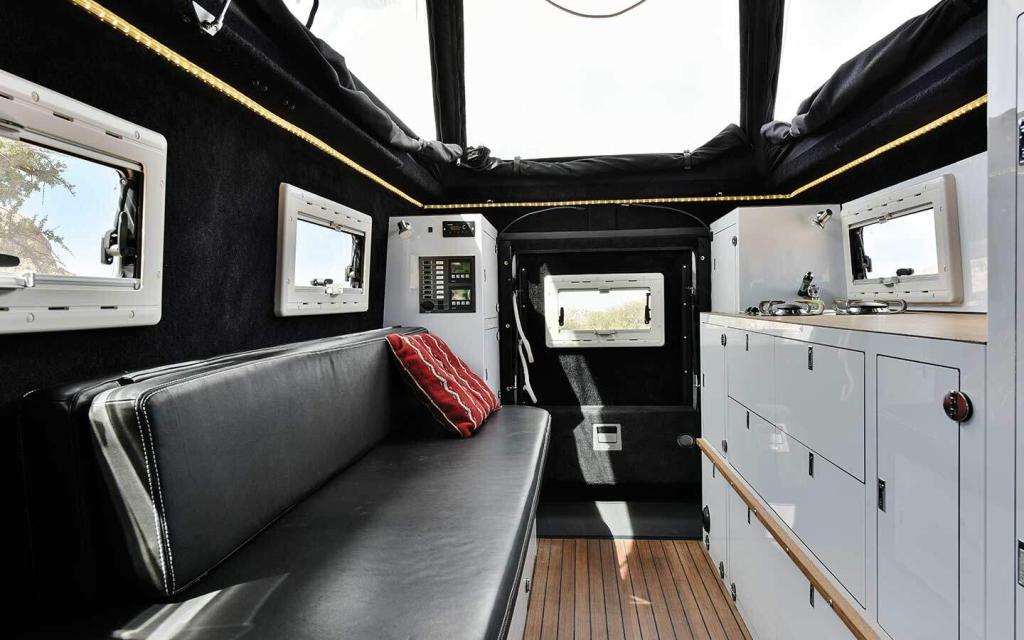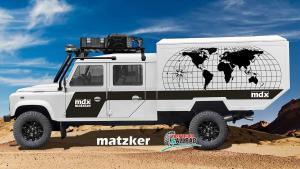Does travelling and living with an overland vehicle automatically mean entail compromise? On the face of it, we’re trying to squeeze a fully-equipped home and two or more people into a cramped space. Not an easy task at the best of times, but if you choose a Land Rover Defender because of its off-road prowess, then interior space is a rare commodity. You can add a bedroom either in or on the roof and extend the living space by adding an awning and/or a tent. However, you need to be prepared to put it up and take it down in all weathers. Not to mention the disadvantages of carrying heavy weights at roof level.
But then again, yachts are a great example of how small spaces can be turned into a comfortable habitat.
THE CONCEPT
Matzker, in Cologne, Germany, has succeeded in creating a comfortable expedition truck without jeopardising the ability of the Defender 130.
Outside, the Defender’s characteristic features remain unchanged and the overall dimensions of (LxWxH) 5330 x 1830 x 2315 mm are well-proportioned. The mdx is just as much at home in small remote villages as it is on the steppe.

The cabin, made of 26/28 mm carbon fiber and closed-cell rigid foam, has a pop-up roof with a large zippered mesh window. Each sidewall has two tilting windows and there’s another in the back door. The rear cross member is reinforced to accommodate a trailer hitch.
Inside, there is a full sized double bed in the roof and a smaller one below. The left side of the cabin has a wardrobe, a worktop, stove, four drawers and five cupboards. Opposite is another wardrobe and a cupboard housing the electronics.
The seating area has room for two and can be quickly converted into the smaller of the two beds. The furniture is made from impregnated Gabun plywood with Alucobond fascias and accoustically insulated.


With the roof lifted, there is plenty of standing room even for those of us close to two metres tall. The interior is amply dimensioned for two even if bad weather has you couped up for longer stretches at a time. At a pinch, you can even squeeze four around the table.
The cockpit is exactly what you would expect from a Defender. However, the front seats can still be pushed far back, because there isn’t a cabin wall in the way. The roof has a black lining which conceals additional insulation.

If you’re looking to upgrade performance or personalise the vehicle with accessories, Matzker has plenty of options to choose from.
In summary, the mdx is a fully equipped overland truck that will carry its passengers in comfort to the remotest of destinations. Just drive, park, push up the roof, and feel at home.
With a brief description of the vehicle out of the way, let’s move on with the experience.
THE JOURNEY
It was the end of February 2016, and time for the inaugural trip in our mdx.
On hindsight, we’d certainly invested a lot of time weighing up the pros and cons of all kinds of vehicles before before finally settling on the Matzker mdx at the end of 2014. In our opinion, the mdx’s ideal balance between interior space and vehicle agility ultimately tipped the scales in its favour. With the Defender’s production days numbered, this was also possibly the last opportunity to buy one new. In September 2015, we finally took delivery of Max, our dream car.
We chose Morocco for our springtime maiden voyage because we could realistically expect to see a lot in the four weeks we had available. The country offers culture, friendly people and, above all, fantastic landscapes. The planned route meant we could test Max’s capability in all kinds of terrain. The journey from Germany to Genoa and onwards from Tangier to Marrakech proved that the mdx is perfectly suitable for the highway, even with its knobbly MT tyres. The extra interior insulation and Recaro seats also played a significant role in making the long drive comfortable. With an average fuel consumption of 11.3 l/100 km and a tank capacity of around 240 litres, fuel stops were few and far between.

South of Marrakesh, we finally reached the mdx’s natural habitat. The mountain passages of the High Atlas over the Tizi n’Tichka Pass, where there was still snow, were mastered easily. We were pleasantly surprised by the tight turning circle in the hairpin bends, thanks to the widened track and adapted suspension settings. We left the main road at every opportunity and looked for nice camping spots on the edge of the numerous dry river beds. The decision to use a compact vehicle proved absolutely correct, especially in the ancient clay villages which were not built with cars in mind. A Unimog or MAN, which we had also toyed with, would have simply been unable to pass through.
Donkey carts and mopeds are the most prolific modes of transport in rural southern Morocco, so we were usually alone on the roads. What we’d normally consider a poor dirt track by German standards, can easily pass for a main road here. We followed the Draa Valley, which at the time was quite dry, and marvelled at the oases, kasbahs, and the geologically diverse mountainscapes. Beyond the valley, the rocky landscape and umbrella acacias reminded us of the East African steppe we’d seen in Tanzania and Kenya.
On our way toward Erg Chegaga, the route was littered with uneven boulder-strewn tracks which really gave the vehicle (and its passengers) a thorough shake. The auxilliary tank shifted on its mountings and rubbed against the propshaft when the suspension compressed. So, we visited Ali Nassir’s famous rally workshop in Zagora. Even though we hadn’t booked a slot, four mechanics soon set to work while we drank tea and savoured a tasty tajine. A pleasant way to pass the time during an impromptu service stop and by early evening, our small problem had been resolved.

In comparison, driving through the soft sand in the dunes near M’hamid was a real pleasure. We lowered the tyre pressures to 1.6 bar and used the on-board compressor to pump them back up again when we returned to the firmer roads leading to Foum-Zguid.
In the past, we’d travelled with tents or a borrowed rooftop tent. So, we quickly settled into the luxury of our cabin with its ambient lighting, on-demand heating and a clear view of the stars. Add to that the ample water supply, solar panels and auxilliary fuel tank, we were self-sufficient and didn’t need campsites. Travelling in Max became more of a pleasure with every passing day. It was simply wonderful to immerse ourselves in nature, photograph the sunrises and sunsets, and meet the local communities. Sometimes we picked spots where camels came to see what we were having for breakfast, or goats joined us in the shade of a tree.
We left the Draa valley near Foum-Zguid and entered the Anti-Atlas. The drought of the last couple of years meant the whole region was arid. The terraced fields of the mountain villages were all but invisible, because the seeds hadn’t sprouted. We found ourselves a spot of level ground between the only two blossoming almond trees and it didn’t take long before one of the villagers and his donkey stopped by to welcome us and point out the nearest well.
We eventually found the best panoramas close to Tafraoute. The famous blue rocks had faded quite considerably since our last visit five years previously and were covered in graffiti. Even so, the naturally formed spherical and conical granite boulders are a sight to be seen and provide a stunning backdrop for sunsets.

We could have spent weeks in the Anti-Atlas, but our ferry was beconning and we soon had to head north again if we didn’t want to miss it. The best option to cover the 800 km from Agadir to Tangier, is to join the brand new, completely empty and well-developed highway. Suffice to say, we were happy to pay the toll and easily covered the distance in a single day. Max even proved his worth in the Tangier rush hour traffic. Certainly not the ideal environment for an mdx, but our winch bumper, the G4 bar and the vehicle height ensured a sufficiently menacing stance that gave us pole position at the roundabouts. What’s more, the narrow streets in the old town are so steep in places that the low gear ratios make manoeuvering in and out of parking slots much easier.
CONCLUSION
All in all, driver and vehicle had a great opportunity to get to know each other during the four week trip. We are already looking forward to the next tour with Max, which could very well be to Morocco again because the mdx is destined to be there.
Introduction: Mike Brailey
Images and Text: Jörg Ermisch







